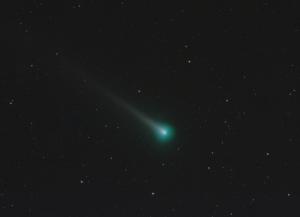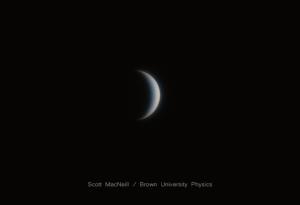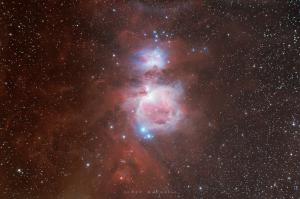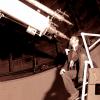Celebration of Space - December 30, 2022
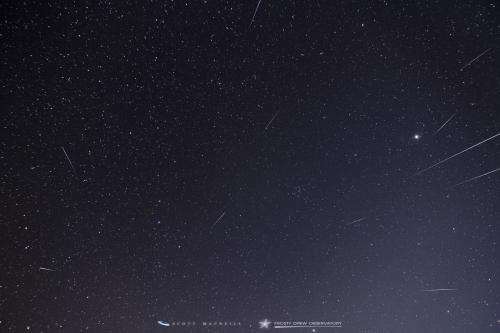
The Quadrantid Meteor Shower at Frosty Drew Observatory. Credit: Frosty Drew Astronomy Team member, Scott MacNeill
This coming Wednesday, January 4, 2023, the annual Quadrantid Meteor Shower will peak. The first meteor shower of the year, and the last meteor shower of the viewing season, the Quadrantid peak is also one of the best meteor displays of the year, bringing a potential increase in regular meteor activity upwards of 120 meteors per hour. The tricky thing about the Quadrantids is that the debris field that Earth passes through, which is created by a potentially dead comet named 2003 EH, is very thin, and orbits the Sun perpendicular to Earth’s orbit. So we pass through this field very quickly, giving us a short peak period of no more than six hours. Timings of the fast peak sometimes fall during the daytime hours for our region. Though in 2023, the peak timings are predicted to occur between 10:00 pm (Tuesday), and 1:00 am (Wednesday), the latter will favor the East Coast. On Wednesday morning, the bright 92% waxing gibbous Moon will be in the sky until it sets at 5:28 am, which will certainly outshine a vast majority of the meteors. Though for about 30 minutes we will have a fantastically dark sky to observe.
Viewing the Quadrantid peak is rather straightforward. You will want to be at a location with a wide open view of the sky that is largely free of artificial light, and be there for 5:30 am, which is when the Moon sets. Lay on your back with your feet orientated towards the Southwest, and look to the zenith (top of the sky) to catch meteors streaking by. The constellation that meteors will originate from is, the now defunct constellation, Quadrans Moralis, which currently resides in the constellation Bootes, near the end of the handle of the Big Dipper asterism. Let us know if you spot any Quadrantid meteors.
In March 2022, a new comet was discovered by the Zwicky Transient Facility in California. The comet is C/2022 E3 ZTF, which is a long period comet that may have an orbital period of 50,000 years. Long period comets are comets that have an orbital period around the Sun of longer than 200 years. Comet E3, will make its closest approach to the Sun (perihelion) on January 12, 2023, and then its closest approach to Earth on February 1, 2023 at a distance of 26 million miles. The comet has been progressively brightening quite nicely, and has formed two distinctive tails – an ion tail and a dust tail. Due to the perpendicular orbit of the comet, related to Earth’s orbit, the comet is currently in excellent position for viewing in the Northern Hemisphere sky, during the morning hours, and will keep getting better as we move through perihelion. The comet is currently being reported at binocular visibility, and could reach the point of naked eye visibility in January. For those looking to catch an early view of the comet, now is the time, as the morning sky is seeing moonset early. Though the best time to catch a glimpse will be after the Moon departs the night sky later this January. Over the next two weeks, the comet will remain in the constellation Corona Borealis, after which it will make its way over the North Star, heading westward across the sky. The best time to catch a view of the comet is about an hour before predawn kicks in – around 4:00 am. Though as January closes, the comet will be above the horizon all night long. So make plans in 2023 to catch a view of the first comet of the year, which could potentially reach naked eye visibility.
From February 2022 – October 2022, Venus has taken on its role as the Morning Star, shining brightly – like an airplane in the predawn morning sky. Well on October 22, 2022, Venus reached Superior Conjunction, which is when Venus arrives on the opposite side of the Sun than the Earth. This is also, consequently, Venus’ full phase when viewed from Earth. Since then, Venus has been orbiting onto the western side of the Sun, and has started to become visible, just this month, over the SW horizon in the evening twilight sky. This now makes Venus the Evening Star, which will continue to shine brightly in the evening sky through the first half of 2023, until reaching Inferior Conjunction on August 13, 2023, which is when Venus will orbit in between Earth and the Sun. So put Venus on your bucket list for 2023, and catch a stunning view of the planet in its role as the Evening Star.
Now that winter is here and the longest nights of the year are happening, we welcome back to the night sky an old fan favorite – The Orion Nebula. Found in the constellation Orion (duh…) the nebula is one of two naked eye visible star forming regions in the Northern Hemisphere sky (the other being the Lagoon Nebula, which is a summertime object). It is quite visible as the middle star in Orion’s sword. Residing at 1,400 light years distant, the nebula is the closest site of massive star formation to the Solar System. Being that the Orion Nebula is naked eye visible, views of the object in binoculars, or a telescope is breathtaking. Though a view in a high powered telescope, like the one at Frosty Drew Observatory, will blow your mind. Take a moment over the next few nights to step outside and welcome the New Year with a beautiful view of the constellation Orion, and take a moment to spot that rather blurry star at the center of Orion’s sword, and remind yourself that you are looking at the birthplace of thousands of infant stars.
Have a fabulous New Year from all the astro-geeks at Frosty Drew Observatory and Science Center.
- Author:
- Scott MacNeill
- Entry Date:
- Dec 30, 2022
- Published Under:
- Scott MacNeill's Columns

